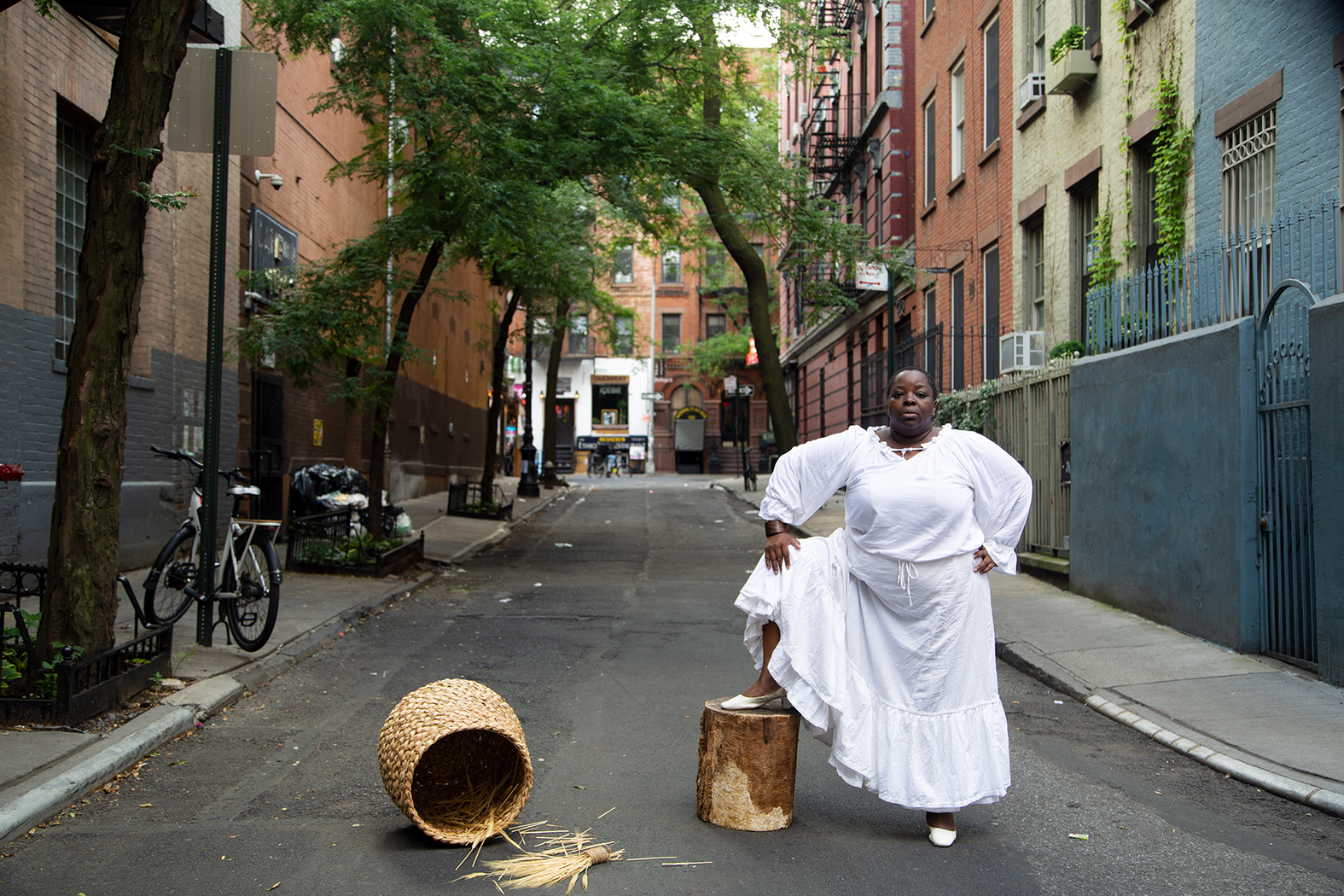Summary
- The series is anchored by a pair of white shoes worn by Faustine in every photo, which is a symbol of white patriarchy, as well as an affirmation that the central subject is a woman.
- Through the use of her body, carefully selected props, and well-researched locations, Faustine reveals the uncomfortable truths and hidden histories of Black people in the US.
- The series was inspired by the stories of (Sara) Saartjie Baartman and Delia. Both were constantly subject to enslavement, exploitation, and sexualization perpetuated by White colonists.
- In our interview Nona Faustine talks about the beginnings of the series, its reception by both art institutions and the audience, as well as how she is hoping the project could bring attention to the traumatic impact of the transatlantic slave trade.
In the photographs, posing either completely nude or partially to fully clothed, Faustine is always wearing a pair of white heels, intended by the artist as a deliberate reference to the white patriarchy. Through the use of her body, carefully selected props, and well-researched locations, Faustine is always in control. White Shoes reveals the uncomfortable truths and incomplete histories of people whose existence and contribution to this nation’s wealth have yet to be adequately accounted for, or respectfully memorialized.
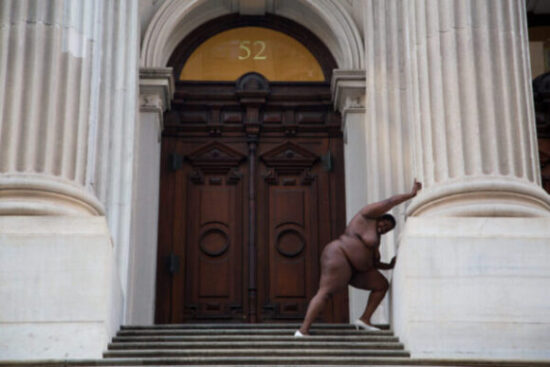
Nona Faustine, They Tagged the Land with Trophies and Institutions from Their Rapes and Conquests, 2013, Tweed Courthouse, New York, NY, USA. Image courtesy of the artist and MACK.
They tagged the land with trophies and institutions
Since their debut in exhibitions and circulation online, the photographs featuring Nona Faustine’s Black, full-figured, female body of the White Shoes series have cultivated a devoted following and critical acclaim. These potent compositions are firmly grounded in concepts that cancel out any suggestion of this content as shocking. The series is anchored by a pair of white shoes, worn by Faustine in every photo, because not only do they signify the white patriarchy, they reaffirm that the central subject is a woman. Faustine is simultaneously communing with her ancestors, speaking up, and physically standing in for countless lost souls and reversing a traumatic power dynamic.
What is most surprising about this series is that her nude body designates the artist as neither exposed nor vulnerable. These images are compelling; her body is used as a physical marker for what has been hidden and pushed into the back of this nation’s subconscious. Seph Rodney, art critic and contributor to the project, characterizes Faustine’s nude body as a naked power suit, one imbued with the ability to push past a hyper-sexualized reading.
“She is battling an entire (United States-based) cultural script that generally favors an attitude of historical amnesia, resents having to learn anything new, idealizes the nation’s founders despite their white-supremacist ideologies, is intellectually both impoverished and dishonest, and most often ignores Black people, particularly Black women, outside of contexts in which they are not providing entertainment.”
The Naked Power Suit in White Shoes: Nona Faustine, MACK, 2021, p. 7.
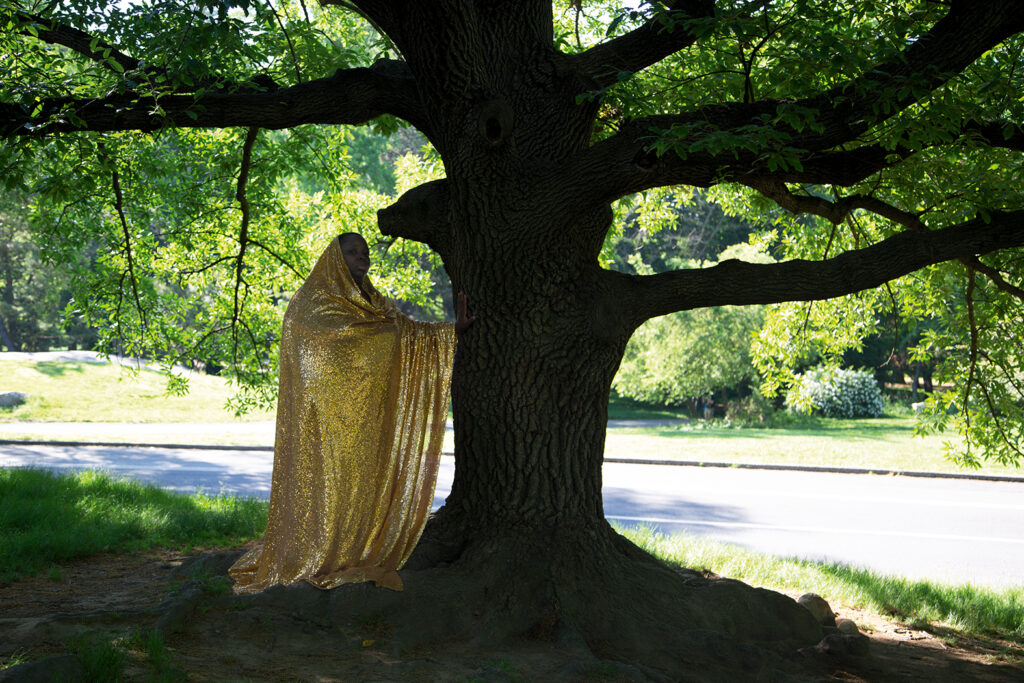
Nona Faustine, Ethereal, 2021, Seneca Village, Central Park, New York, NY, USA. Image courtesy of the artist and MACK.
The cover of the book features a grainy detail from a photograph early on in the series: Faustine is wearing nothing but her white heels and is pushing against a marble column of the Tweed Courthouse in downtown Manhattan, a late 19th century building that was built on sacred land where the bodies of African slaves were laid to rest. This building is just steps away from the African Burial Ground Monument, where a massive colonial-era gravesite was discovered in the 1990s and soon after became a place for remembrance.
In a photograph later in the series, the artist is seen in profile and kneeling in prayer at this site. Her body is wrapped in a regal gold fabric that Jessica Lanay, poetess, art writer and contributor, aptly describes as a chrysalis. Given the opportunity to examine the complete set of photographs in Faustine’s book, we bear witness to the artist’s transformation over the course of a decade, digging around for traces of forgotten African American histories, and often reimagining what would have been if these spaces were properly preserved and not demolished or paved over.
From her body came their greatest wealth
White Shoes opens with Venus of Vlack Bos (2012), a studio portrait of the artist seated on a stool covered in drapery, and nude except for a sparkling tiara on her head, elegant long white gloves on her hands which are placed properly on one knee, and, of course, the white heels, impeccably clean at this point in the process. Faustine’s pose is dignified yet defiant; she wears the accoutrements of a triumphant beauty pageant contestant or, as the artist has suggested, Queen Elizabeth II. White Shoes was conceived of by Faustine while reading about (Sara) Saartjie Baartman, also known as the Venus Hottentot, and a female slave named Delia who lived on a plantation in South Carolina.
Baartman was a South African woman brought to Europe, most likely through dubious circumstances, where she was exploited and forced to parade her almost completely exposed body on stages for audiences to gawk at, for a fee that was pocketed by her male handlers. To make matters worse, Baartman’s body was posthumously dissected, and parts of her body placed on display in Paris’s Museum of Man where they stayed until her remains were repatriated to South Africa at the request of Nelson Mandela in 2002. As for Delia: according to Molly Roger’s 2010 book Delia’s Tears, this woman lived a life of relative anonymity with the exception of a daguerreotype taken of Delia from around 1850, and discovered in the attic of the Peabody Museum in Cambridge, MA, in 1976. Facing the camera, Delia appears stripped down to the waist, her torso exposed, and clearly not a willing participant. Delia was the subject of curiosity and pseudoscientific studies, essentially stripped of her humanity, as was Baartman.
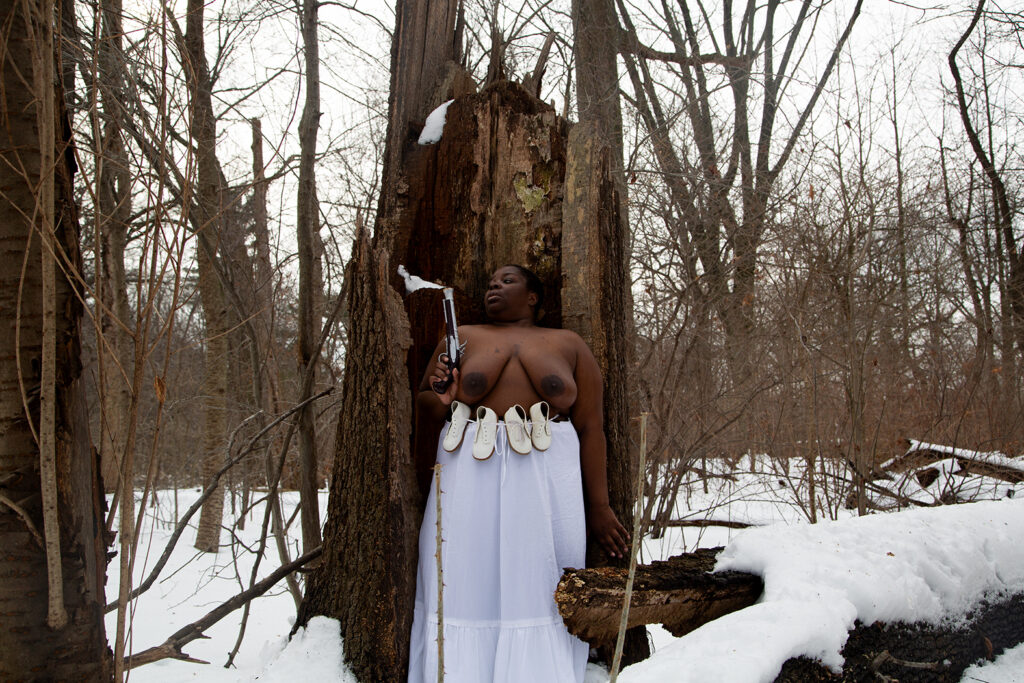
Nona Faustine, Lobbying the Gods for a Miracle, 2016, Prospect Park, Brooklyn, New York, NY, USA. Image courtesy of the artist and MACK.
The injustices that swirl around the lives of Sara Baartman and Delia set in motion the process that guided Faustine through her journey to restore the denied humanity of her African ancestors. The artist stands completely nude, her hands in shackles, wearing the ubiquitous pair of white shoes, on top of a wooden box at 74 Wall Street in Manhattan’s financial district, also known as the Enslaved auction site from 1711 to 1762. Every photograph of White Shoes is embellished with thoughtful titles further explained by the artist in the notes section at the end of the book, that enlighten the reader with brief histories of the chosen locations. The following is an excerpt from Faustine’s explanation of the Wall Street site chosen for From Her Body Came Their Greatest Wealth,
“Enslaved people came off the ships docked at nearby slips and were sold at this location. They could be bought and sold throughout New York City, in hotel lobbies, coffee house, and everywhere in between. Enslaved people cleared the forests, built the roads and buildings, built forts and the wall that gave Wall St. its name. Human beings were the first commodity of the greatest finance capital in the world.”
Notes in White Shoes: Nona Faustine, MACK, 2021, p. 109.
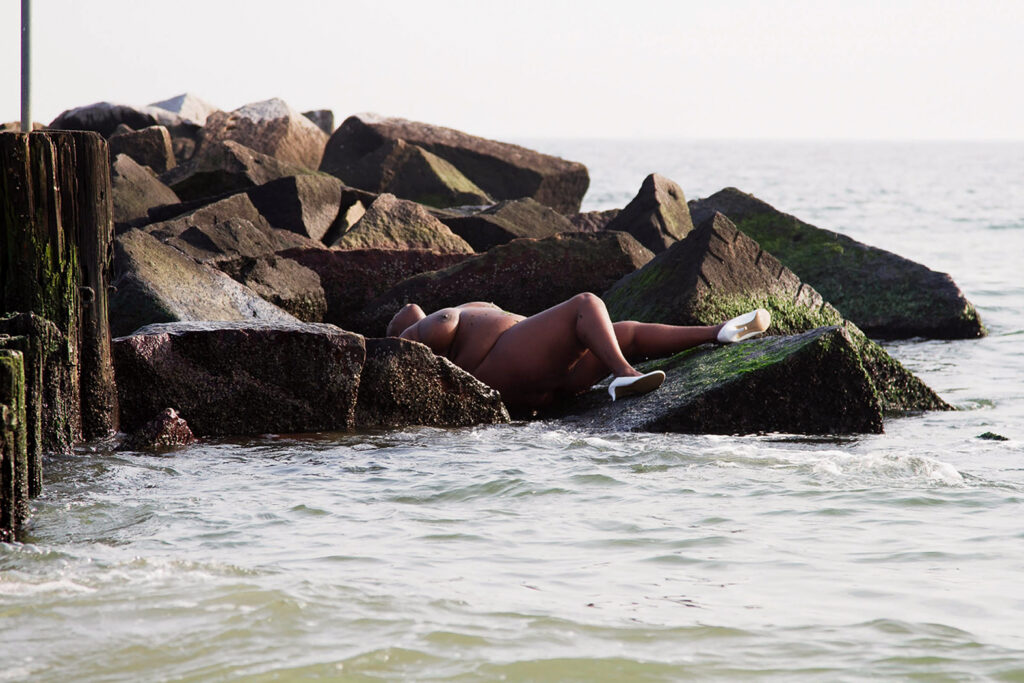
Nona Faustine, Like a Pregnant Corpse the Ship Expelled Her Into the Patriarchy, 2012, Atlantic Coast, Brooklyn, New York, NY, USA. Image courtesy of the artist and MACK.
Of my body I will make monuments in your honor
Every photograph in this series stimulates an endless stream of thoughts, and could individually be the subject of long discussions. Seen together in book format and enhanced by the essays contributed by Seph Rodney, Jessica Lanay, and Pamela Sneed, plus an artist statement and interview with the artist as well as the aforementioned notes, White Shoes is a generous offering to anyone fortunate to spend time with this project. Over the course of a decade, the artist worked through the indignation, rebellion, liberation, and self-preservation that runs through generations of African Americans, whose collective memories and histories tug at contemporary conditions.
White Shoes is not just a collection of self-portraits or documentary photographs, but should be read as a transformative journey across time firmly rooted in specific spaces and embodied by Faustine. In pursuit of unearthing this nation’s concealed histories, White Shoes exposes a past that has been glossed over, erased, and otherwise forgotten by a collective memory that for the most part, fails to implicate the North and its role in the slave trade, especially in the construction of New York City.
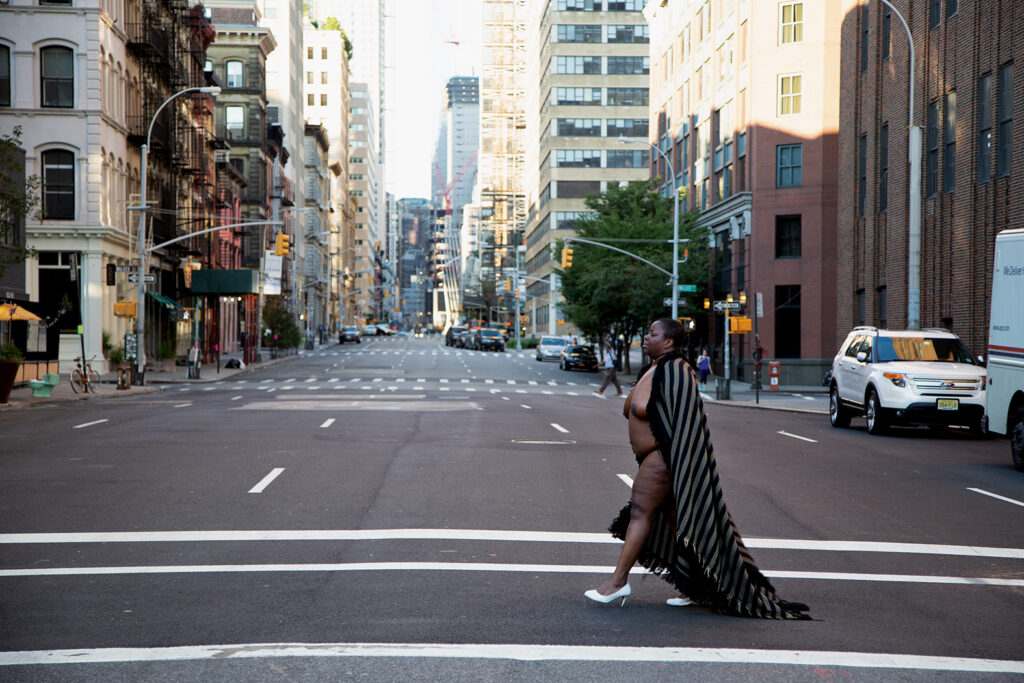
Nona Faustine, Walk to Freedom Frederick Douglass, 2015, Church St. & Lispenard St., New York, NY, USA. Image courtesy of the artist and MACK.
Interview with Nona Faustine
JM: Over the course of White Shoes, it appears that not only are you communicating with the ancestors, the past, but undergoing a gradual transformation that ends optimistically with the final phase of photographs from 2021. Do you agree with this observation? Can you comment further on the shifts that take place from 2012 through 2021?
NF: That is a good observation. There was a lot of living in between that slowed the process down and I think was a good thing. Raising and caring for a child and an elderly parent, the job of being an artist promoting myself, etc. The entire project once it was conceived was envisioned from beginning to the end. I never wavered from the original concept and its execution. It just took me that much longer to fill it in, at times I wanted to rush the process and then at other times I didn’t. I think that time and space informed the images to me. I think photographs need time to breathe and with each site photographed a path was laid out for me and the direction made clear. I thought about each site for a long time before I arrived at it. So when I went there I almost knew it and felt it. Still some things were a surprise like my physical reaction to actually being there.
JM: Say Her Name (2016) stands out for its response to contemporary police brutality in this country and the 2016 death of Sandra Bland while in police custody in Texas. This is a deeply personal photograph because it was taken in your family’s apartment, includes your mother who is seated with her back to the viewer and facing you as you lay across what looks like a coffin covered in the American flag. I want to take this moment to offer my deepest condolences for the loss of your mother. Can you discuss your decision to take this moment in White Shoes to detour from the past and address a contemporary and deeply personal moment in time and space? Furthermore, in the final push to complete this series in 2021, how did the resurgence of the Black Lives Matter movement in response to the tragedies that occurred around that same time influence the final outcome of those photographs?
NF: When Sandra Bland died in 2015, I was greatly affected like many in the nation and around the world. I was making new images for my solo exhibition, My Country, towards the end of 2015 into the beginning of 2016. I took the opportunity to create this image in tribute to women killed due to police brutality. I didn’t know there would be others like Breonna Taylor. Part of me saw the similarities of our lives. The ordinariness of the circumstances around Sandra Bland’s death. She was just driving to work, an ordinary common thing, when she was pulled over for a minor traffic violation. I thought of her family, my family, and how my mother would feel if it was me; it could be me, any of us. How death visits many African American families. The series was conceived and emerged in 2012. Black Lives Matter movement was created in 2013. To say the movement did not have an effect on my image making takes nothing away from them. It just says that many minds were thinking hard and feeling the same way and figuring out a response to the events in the country, contemporary culture, and how to address the changes we wanted to see. I just continued with the series as was planned.
JM: Can you discuss in a little further detail the type of pushback you experienced from institutions that were hesitant to exhibit work from the White Shoes series and locations where you had difficulty doing a photoshoot? Are there any locations that denied you access?
NF: The Studio Museum of Harlem and the David C Driskell Collection in Maryland State University are the only African American institutions out of 13 museums that have my work in their permanent collections and are two of three African American institutions that have exhibited my work. One African American curator approached me wanting to exhibit the images at an African American institution only to be told later the institution did not exhibit work with nudity or frontal nudity. Another African American institution approached me about an exhibition only to later rescind the offer for reasons that I’m not completely clear of, another institution told the curator in a traveling exhibition I had been part of that they did not accept frontal nudity. Due to the historical trauma around the way the Black body has been exploited in and out of slavery and through media I understand this resistance. This work is not exploitive and it is not just about slavery but again I understand. In doing photo shoots at institutions, I had a bit of resistance from Weeksville Heritage Center in Brooklyn with one particular person who was the gatekeeper but once I reached out to the higher ups there the door was opened and everything went well, I greatly appreciated it. People are protective of their institutions, access, and how their sites are portrayed and I understand that as well.
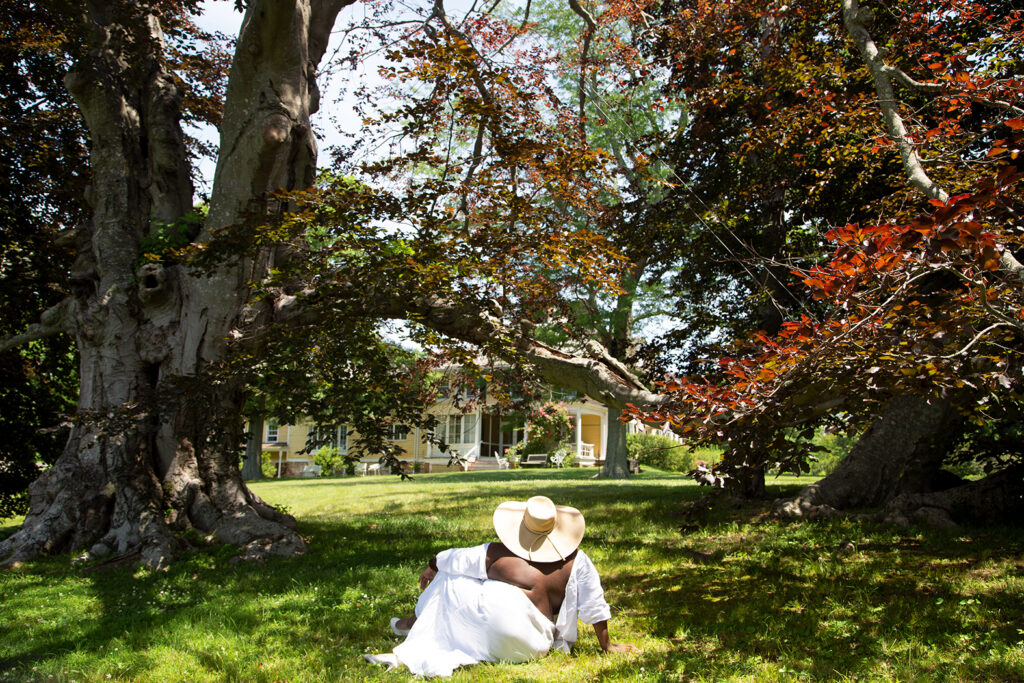
Nona Faustine, There are few markers left but your black body is the marker. The land does hold the memory of your existence. You only have to put it there in its natural state to remember. – Harriet Tubman, 2021, Sylvester Manor, Shelter Island, New York, NY, USA. Image courtesy of the artist and MACK.
JM: At what stage in the process of creating White Shoes did you start to receive serious interest from curators, critics, scholars, dealers, etc.? How did the feedback affect your process?
NF: Once my work went viral in 2015, after a Huffington Post article, and then a popular blogger reposted it – Black Girl with Long Hair – it opened my work up to many critics, curators and scholars. I never let the feedback affect my work.
JM: How do you feel about the discussions that have developed around White Shoes?
NF: That’s a funny question to me because I don’t know all the discussions being had, so it’s hard for me to answer. The reviews I’ve read or discussions that I have had, I’m often surprised how the work has affected people and I am touched and overwhelmed when it goes beyond my imagination of what I had hoped in creating the series. That people understand what I’m trying to convey in using the power of image making is beyond what any artist can ask for.
JM: Do you feel that the work is being digested and circulated in a way that holds true to your artistic intentions?
NF: Mostly yes, though I feel it’s still too early for me to answer that question. I will certainly continue to fight for my vision of the series and call it out when it does not feel right. My greatest wish is that it would protect these African American sites, many of which are still under threat not only in NYC but around the country. Like the cemetery in Corona Queens, Weeksville Heritage Center in Brooklyn.
JM: What are some aspects that you would like to correct in regards to the developing discourse around you as an artist and this body of work?
NF: Mostly I don’t like the way Google collects images from Artists. I can’t control the way the images are circulated and used. Emerging Artists have to promote themselves and give interviews about their work but then some other entity encroaches on that without my permission.
JM: What are your expectations now that White Shoes is out in the world in book format?
NF: I just hope that the message goes as far as it can, and reaches as many people as possible and moves people to rebuild new systems that address and heal around the trauma of the Transatlantic slave trade and its Diaspora. I want more credit and importance given to under-represented voices that have built and contributed at great expense to America and the world. Artistically, I hope people enjoy the images and bring them into institutions so that more people can see them.
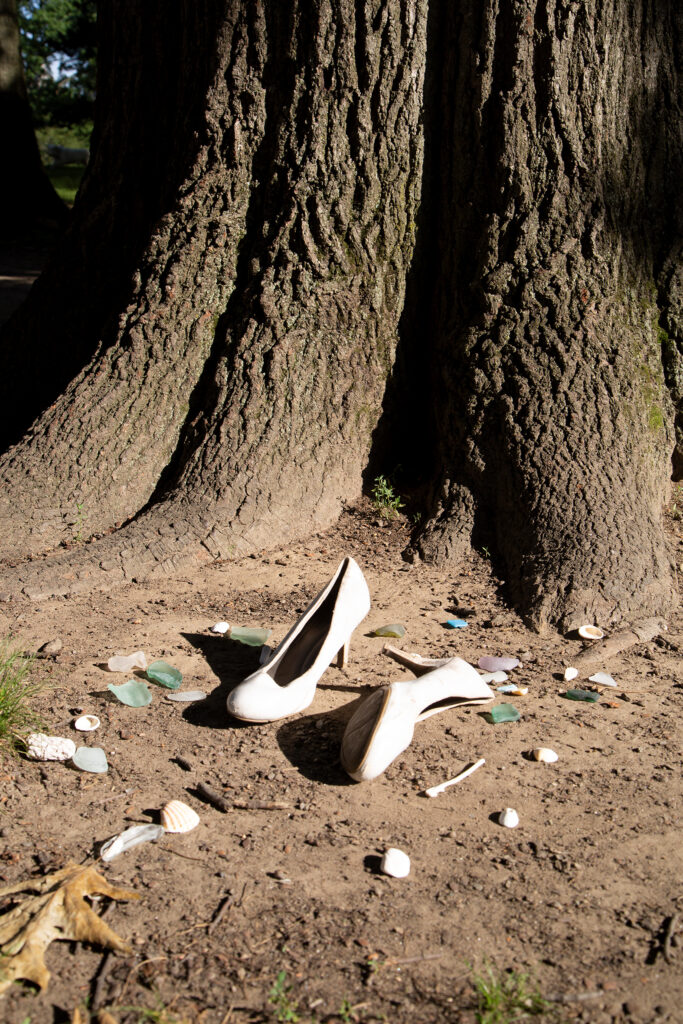
Nona Faustine, Benevolent spirits, tracing steps free bare feet from this world to the other, 2021. Image courtesy of the artist and MACK.
We would like to thank Nona Faustine and MACK for facilitating this wonderful opportunity to interview the artist and review the book Nona Faustine: White Shoes.
The project is now on view at the Brooklyn Museum in New York. The show Nona Faustine: White Shoes runs until July 7, 2024.
